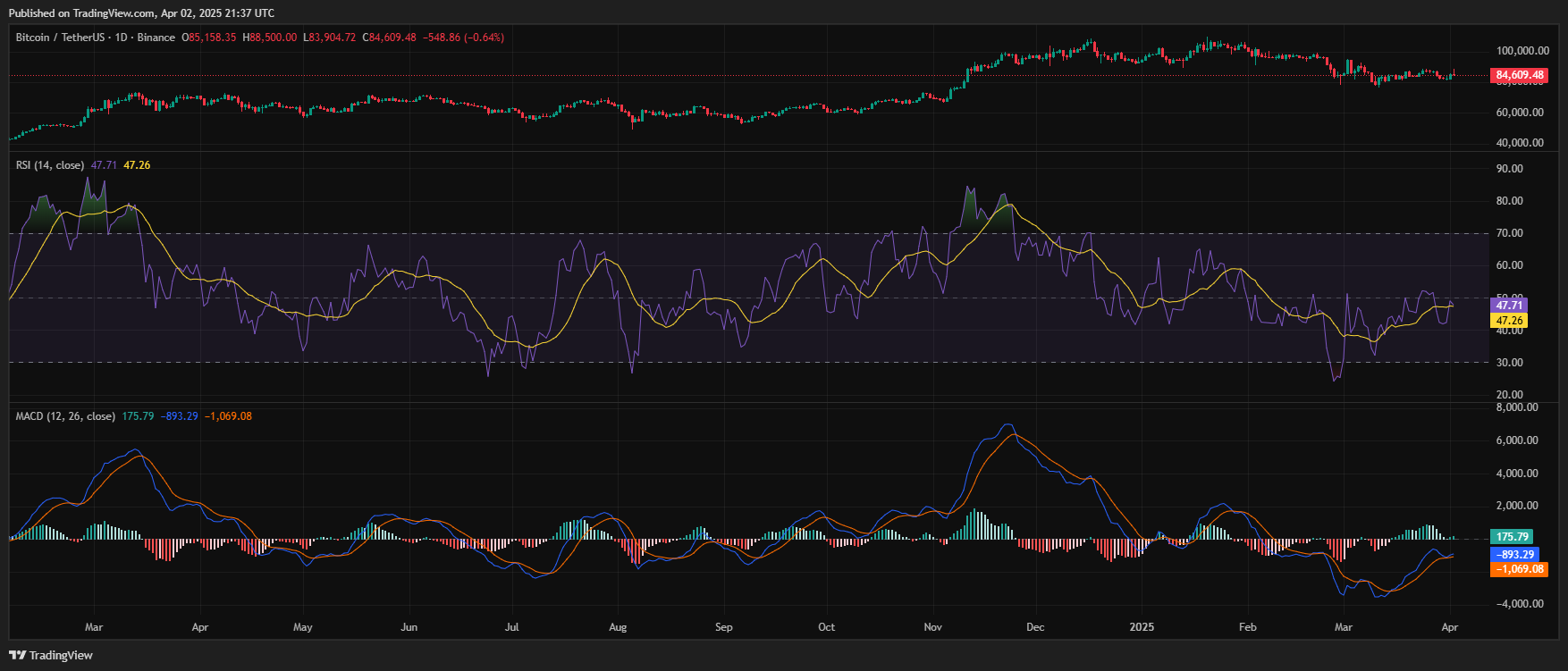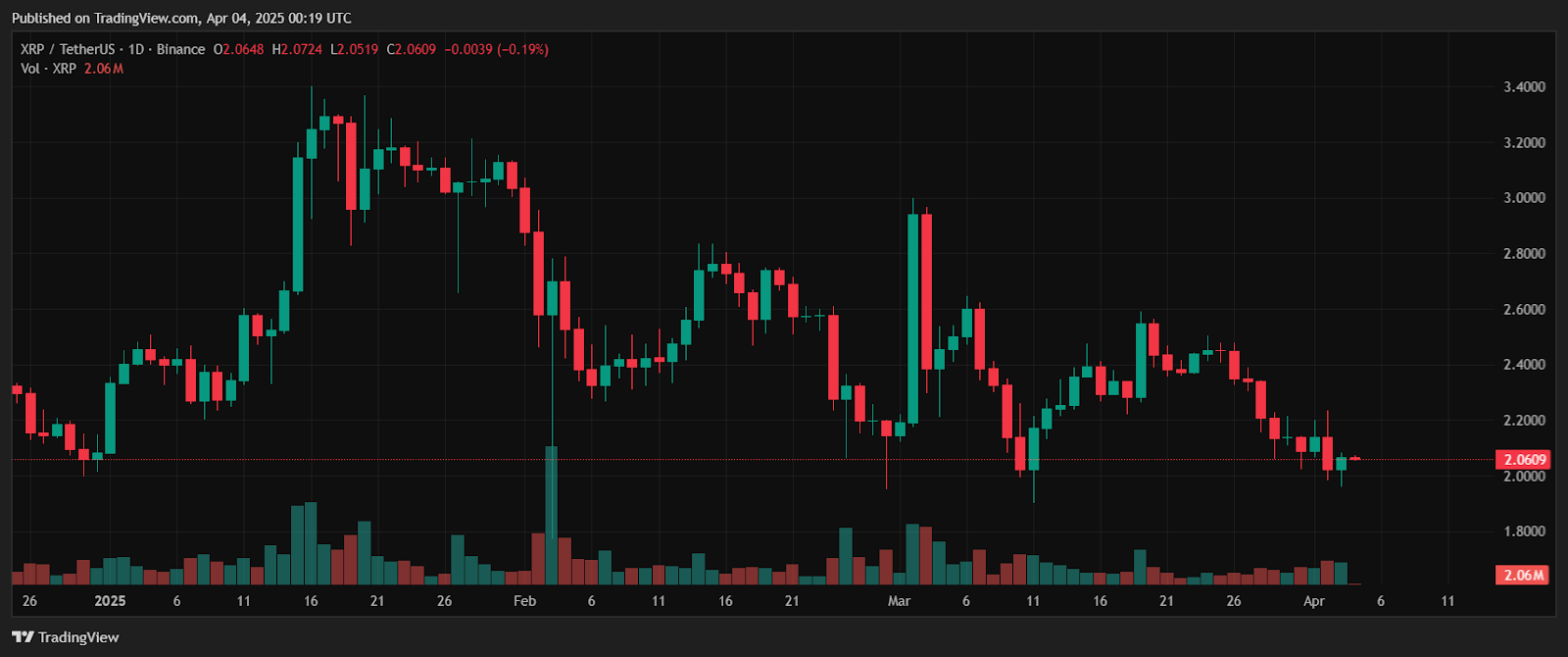 CaryptosHeadlines Media Has Launched Its Native Token CHT.
Airdrop Is Live For Everyone, Claim Instant 5000 CHT Tokens Worth Of $50 USDT.
Join the Airdrop at the official website,
CryptosHeadlinesToken.com
CaryptosHeadlines Media Has Launched Its Native Token CHT.
Airdrop Is Live For Everyone, Claim Instant 5000 CHT Tokens Worth Of $50 USDT.
Join the Airdrop at the official website,
CryptosHeadlinesToken.com
- President Trump confirms 25% tariffs on foreign-made automobiles, causing immediate reactions in crypto trading patterns.
- Trump introduces “reciprocal tariffs,” potentially altering U.S. trade relationships and influencing cryptocurrency stability.
On Wednesday, Bitcoin’s value experienced a temporary surge followed by a decline amidst unfolding news from the White House. President Donald Trump confirmed the imposition of anticipated tariffs, affecting various foreign-made goods, including automobiles.
Speaking from the Rose Garden, Trump emphasized that these measures were a response to long-standing unfair trade practices against the U.S. He stated, “Our country and its taxpayers have been ripped off for more than 50 years. But it’s not going to happen anymore.”
Following these announcements, Bitcoin reached a high of $87,800 but later settled around $85,500, marking a 1.1% decrease within the hour, as reported by CoinGecko. The cryptocurrency’s volatility was notably influenced by Trump’s comments and the broader market’s reaction to the tariff news.
The President detailed that starting at midnight, a 25% tariff would be applied to all foreign-made automobiles. Additionally, Trump introduced what he called “reciprocal tariffs,” aimed at countries that impose levies on American goods.
These tariffs will be set at about half the current rates these countries charge the U.S., encompassing all their tariffs, non-monetary barriers, and other forms of trade barriers. Trump also mentioned a 10% “minimum baseline tariff” as a charge for foreign nations to access U.S. markets, further elaborating on the new fiscal barriers.
In the weeks leading up to this announcement, President Trump had dubbed the self-imposed tariff deadline as “Liberation Day,” signaling changes in trade relations with some of America’s largest trading partners. The approach to tariffs has been described variably by the administration, with White House Press Secretary Karoline Leavitt noting that while the strategy was being “perfected,” a firm decision had been made.
This uncertain environment has led to fluctuations in cryptocurrency prices, as investors speculate on the potential economic slowdown or heightened inflation resulting from the tariffs. ETHNews analysts suggest that these tariffs could influence the Federal Reserve’s decisions regarding interest rate adjustments this year, potentially maintaining higher borrowing costs to manage inflation, which could, in turn, apply pressure on risk assets like cryptocurrencies.
Amidst these developments, Bitcoin had previously dipped to as low as $77,000 last month. Thomas Perfumo, a global economist at Kraken, noted that while the market initially reacted to the tariff news with heightened anxiety, much of the impact seems to have been already factored into Bitcoin’s current pricing. He observed that despite the ongoing concerns, the market has largely absorbed the effects of these trade measures.

The current price of Bitcoin (BTC) is $84,491.30 USDT, reflecting a daily loss of −0.78%. Today’s trading range has moved between a low of $83,904.72 and a high of $88,500.00, showing high volatility within a tight macro structure. The 24-hour trading volume is around 33,720 BTC, indicating active market participation but also hesitation near key resistance levels.
Over the last 7 days, BTC has dropped −3.38%, continuing its downward pressure after failing to hold above the $88,000 zone. In the past month, BTC is down −10.43%, though it remains strong in the mid-term with a +38.99% gain over the past 6 months, and a +21.24% increase year-over-year. However, it is still −9.76% year-to-date, reflecting the broader market consolidation after the February peak.
Technically, Bitcoin is testing the lower boundary of its short-term ascending channel. A failure to hold $84,000 could trigger a quick move down to $81,500–$80,000, where buyers have previously stepped in.

Conversely, a clean break above $88,300 could revive bullish momentum and open the door toward $90,000–$93,000, where heavy resistance and liquidity lie. Momentum indicators are neutral to bearish; RSI is below 50, and MACD has yet to show a bullish crossover.













